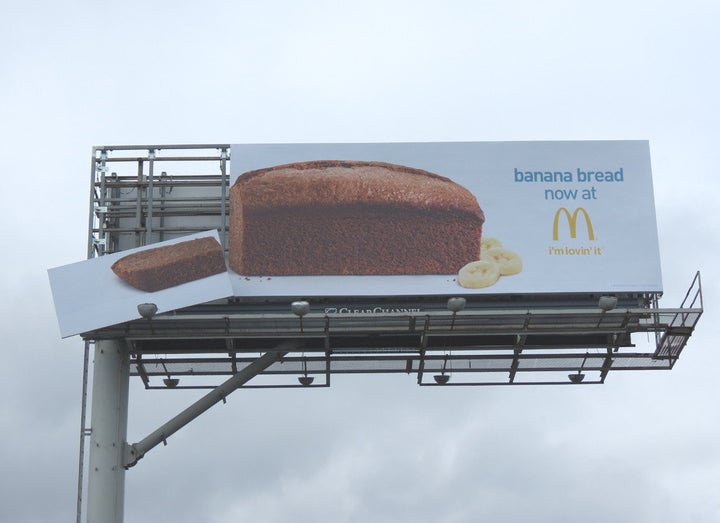
I borrowed the phrase "the democracy of air" from a poem by Stephen Dunn. He's talking about 9/11. I'm writing about billboards, urban landscape and political issues. The issue of electronic billboards is coming to a head in Los Angeles. Both the court and city council are trying to figure out how to preserve revenue from these money-spinners and create good urban policy, while reconciling the issue of what the LA Weekly termed the "24-hour digital sunrise," due to the perpetual light the billboards emit. Residents are complaining. Local businesses are suing. It's a story of business, urban landscape and democratic political issues. And there's a lot of money at stake in a city facing a $216 million deficit. The latest article in the LA Weekly spells out the complicated controversy better than I can.
While I've been loosely following this story, I've had occasion to think about billboards in a new way thanks to a project called Urban Air. Artist Stephen Glassman and a team of engineers, tech experts, scientists and advertisers want us to experience the billboard in a completely new, three-dimensional way. The project is simple. Take an ordinary billboard somewhere in L.A. (probably near a freeway), thank Summit Media for donating the space and install a suspended bamboo garden where movie, liquor and television ads used to reside.
Urban Air, to use Glassman's terms, will cause the passer-by to "reframe, re-contextualize, re-see billboards as an urban landscape infrastructure and not just a means of selling stuff." The project is interesting for the pleasing immediacy of being able to visualize tall stalks of bamboo growing out of billboard. Like so many seemingly simple ideas, there are underlying political, artistic and subversive elements at work.
Glassman has worked in the field of public art for over 20 years. He describes his path as an artist working in the public realm in this way:
The key to making a really great work of art is finding the right problem that interests you. And then it's just a question of solving that problem. The key is the quality of the problem. So I originally wanted to move my work from galleries to the public realm because I wanted to deal with scale and social impact. I wanted that in my work. The public commissions gave me that opportunity... I was doing 150-foot works and bridges and all kinds of things. After almost two decades of doing that, I found myself bumping up against walls again and feeling horribly confined. I was wrestling with that. What's the next break through in the work. I thought, "Can it be bigger? Can I get more money? Was the answer bigger or more?" It occurred to me that the key to it is not the content, but the context that I'm working in. To completely shift the context of my work.
That shift now involves billboards. As I've been driving around the city the past few days, I've been seeing billboards with fresh eyes. Trying to see them not just as vehicles for advertising that annoy or cause my eyes to glaze over due to familiarity, but to see them as an urban, architectural structures. To see them with the eyes of an artist, like Glassman.
I'd been working with billboards because structurally I think they're phenomenal. Those extreme cantilevers. When the big Northridge quake hit and the freeways fell, that's when I was commissioned to do a lot of bamboo installations around the city and in these sort of devastated areas. You know, the freeways fell and buildings fell and bridges fell and the billboards didn't fall. I find them just phenomenal as structures. I find them beautiful as forms. They don't interest me so much as messaging. There are a lot of artists' billboards that are really just billboards. It's a hipper, truer billboard. But Urban Air is really a complete transformation of the billboard. It really becomes a completely other vehicle, with a completely other life. It's has a three-dimensional life.
If Glassman and his team are successful in raising funds, this vision will become reality. Alex Kouba of Summit Media has offered billboard space based on Glassman's specs for Urban Air. The two met at an art opening and Glassman ended up whipping out his phone to show Kouba a mock up of the project. Urban Air is currently running a KickStarter campaign to raise funds to transform the first billboard.
Here's where the phrase "the democracy of air" really comes into play. Imagine driving along the 10 Freeway, you're stuck in traffic and you look up to see a billboard sprouting, growing and you're checking out its daily progress. A garden in the sky, challenging the horizontal plane we're accustomed to seeing with billboards and stretching our gaze out and upward. Crowd-funding sites like KickStarter enlist small donations to bring projects like Urban Air into fruition. Throw in five bucks and you've just voted for this project. You've just voted for a constructive, perspective-shifting work of art in the public space.
But it goes deeper than that. I commented to Glassman that infrastructure isn't sexy. He countered that "great civilizations are defined by their infrastructure. Infrastructure is a reaching across. It's about interconnection. It's not about the single, vertical entity." From there we moved into a political discussion that I won't recount here, but the ideas of context and negative space came up.
There's something I've been very excited about conceptually. My drawings are mostly white. The black sort of chisels away at the white to give it volume, and that's the negative space, so it's like you're altering the concept of negative space to give it identity. Urban Air is an intuitive piece of art coming out of my studio. It occurs to me that context is part of the negative space of public sculpture. Painting in two dimensions you have figure-ground. In the public realm, you have content and context. And that context can be defined in lots and lots and lots of different ways, but really in a straight-out material way, when we talk about negative space, what we talk about is air. That air is the context that we live in.
How do we define and structure that negative space? What constraints does urban architecture put around the open air? Early in his career, Glassman studied the art of Japanese kites. He said, "The kite must be beautiful. It's a beautiful form, but the function of the kite is to take your eye to the sky." Like that beautiful kite, Urban Air draws us in, moving beyond the current debate in the L.A. City Council and District Court.
